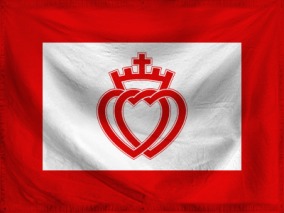2
Santonian Cuisine
Saintonge is a country with a famous gastronomic tradition. The country had started using its gastronomy to attract tourists, with "Food Tours" being offered to foreigners.Saintonge also fiercely protects its culinary heritage. Saintonge's Ministry of Culture maintains and enforces a system of protected designation of origin called "appellation d'origine contrôlée" (AOC), which regulates labeling and production. For example, the appellation "Champagne" for wine can only be applied to sparkling wines made in the ancient province of Champagne meeting certain production standards and methods.
Wine
Saintonge has about 900 kinds of wine, half of which have AOC status. The wines can be divided as coming from 6 wine regions: Béthagne (Brandérion, Côtes du Nord, Douce, etc.), Griffonné (Castellane, Trieux, etc.), Lac (Bordeaux, Mirande, Perthois, etc.), Pouilles (Clavenne, Corb, Piémontaise, etc.) Val de Loine (Aurignais, Beaujolais, Tyrosse, etc.), Val de Saine (Beaune, Champagne, Châteaubriand, etc.). Only a few will be described here.
Champagne
Champagne is a sparkling wine, which has become genericised because of its popularity. In Saintonge, though, all wines labeled 'Champagne' must come from an area within the ancient province of Champagne (departments of Puy-d'Or, Dropt, and parts of Sambre, Rhue, and Saine-et-Loine). The Champagne area is further divided into "red" and "white areas". "Red Champagne" is made around Lagny-sur-Saine and Montereau-fault-Yèvre, while "White Champagne" is made around Sens and Villefranche-en-Champagne. The Champagne region is one of the largest and most productive AOCs; half of the Champagne wine produced are destined for export.
Beaujolais
Beaujolais wine is a light-bodied red wine from the ancient province of Beaujolais (department of Aure and part of Seudre). It had a surge in popularity during the 1990s, but is still a common table wine in eastern Saintonge.
Bordeaux
Bordeaux is a corruption of bord des eaux or "waterfront" as the wine is being produced on the shores of Lac Amer in the department of Basses-Brômes and a few communes of Bouche-du-Rhâne.
Blaye
Blaye is similar to Bordeaux wine, only that the grapes are grown on terraces overlooking the Coole River in the old province of Blayais (Loing). It is said that Blaye wine is the precursor of the more famous Bordeaux, as the winemakers from Basses-Brômes trace their origin from winemakers from Loing who had brought their craft to southern Saintonge.
Beaune
The non-sparkling relative of Champagne, Beaune wine is produced around the city of the same name. The area of production extends from Vitry-sur-Saine (Dropt) to Saineauxence (Côle).
Clavenne
Probably the weirdest Santonian wine, Clavenne wine is not only sparkling, it is also "glowing" because of the background radiation it emits. Clavenne is made from Chardonnay grapes grown on the seaward slopes of Montmagique in the department of Basses-Alpes. The soils of Montmagique are high in trace radioactive elements (indeed, most of Saintonge's uranium is also mined underneath Montmagique and the adjacent hills), which become incorporated into the grapes and eventually the wine. The white wine emits an eerie faint blue glow under dark light, but is perfectly safe to drink - in moderation. A bottle of Clavenne will give you a radiation dose similar to a mammogram or 30,000 bananas.
Chartreuse
Not exactly a wine, but a liqueur, Chartreuse is produced in the department of the same name, along the slopes of the mountain range where the department is named after. Made from distilled Côte de Lisle white wine, the alcohol is steeped with 130 herbs to make the liqueur.
Cheese
Saintonge has about 1,200 kinds of cheeses, of which 100 have AOC status. Only a few will be described here.
Brie
The most famous Santonian soft cheese, Brie is a soft cow's milk cheese with a soft white edible rind. It is made in the region around the town of Brienne (Dropt). Brie is very famous in Saintonge that only 10% is left for export, and can command high prices in foreign markets.
Camembert
Brie's competitor in the soft cheese category, it is made around the village of Camembert and the city of Barenton (Basse-Bléone). it is a descendant of the Brie after cheesemakers from Champagne migrated to Germandie. It is less well-known than Brie, but is very popular in southern Saintonge.
Coulommiers
Coulommiers is another less well-known cousin of Brie produced around the town of the same name in the department of Saine-et-Loine. Production extends from the Coulommiers to Charny-sur-Loine (Saine-et-Loine), although production is decreasing. Derided as the "poor-man's Brie", most Santonians cannot really tell the difference between Coulommiers and Brie.
Roquefort
Known as the "King of Cheeses" in Saintonge, Roquefort is a blue sheep-milk cheese produced around the town of the same name in the department of Semois, considerably close to the country's capital. Roquefort is aged in seaside caves on cliffs overlooking the sea, where the sea spray imparts a slightly salty taste to the rind. The Santonians protect Roquefort so closely that a proposed seaside autoroute from Lohan (Semois) to Embrun (Trieux) was rerouted away from Roquefort towards Richemont and Lambesc; it was thought that the increased traffic will destroy the microclimate inside the seaside caves.
Saint-Nectaire
Produced around the village of the same name in the Luberon plateau, Saint-Nectaire is another soft cheese made from cows milk, which has a hint of hazelnut taste.
Comminges
Comminges is a semi-hard, fragrant, raw-milk cheese made in the old province of Comminges, covering the present departments of Limagne and Aubrac.
Nébrodes
Nébrodes cheese is a mild, yellow hard cheese made from cow's milk. Covered in a thin layer of red wax, Nébrodes cheese keeps well and has been traditionally brought on seafaring ships as supplies for sailors.
Douvres
Douvres cheese is a brined sheep-goat milk cheese. Produced in the old province of Domnonée, Douvres is frequently used in salads, pastries, and as table cheese.











